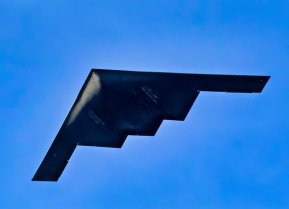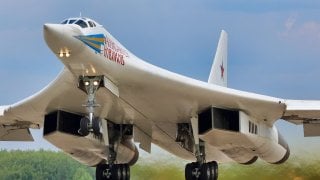Russia's New Tu-160M Bomber Looks Like Trouble for NATO
Russian President Vladimir Putin's flight in the modernized Tu-160M strategic bomber, a symbol of Russia's advanced nuclear capabilities, underscores the country's ongoing commitment to maintaining a formidable nuclear triad. The Tu-160M, an upgrade of the Cold War-era "White Swan," features enhanced armaments, electronic warfare systems, and new NK-32-02 engines.
Summary: Russian President Vladimir Putin's flight in the modernized Tu-160M strategic bomber, a symbol of Russia's advanced nuclear capabilities, underscores the country's ongoing commitment to maintaining a formidable nuclear triad. The Tu-160M, an upgrade of the Cold War-era "White Swan," features enhanced armaments, electronic warfare systems, and new NK-32-02 engines. Russia's plan to expand its fleet with over 50 new Tu-160Ms, alongside the development of the PAK DA stealth bomber, demonstrates its intention to bolster its strategic military forces. The Tu-160M's role as a key component of Russia's nuclear deterrence strategy highlights its strategic importance in global security dynamics.
Over 50 New Tu-160Ms: Russia's Plan to Strengthen Its Strategic Bomber Fleet
Russian President Vladimir Putin in February wanted to send a message to the West about his nation’s nuclear capabilities. Putin took a 30-minute flight on a Tupolev Tu-160M strategic long-range bomber, and Putin was quick to praise the aircraft.
The Tu-160 was developed during the Cold War, but the modernized Tu-160M that carried Putin came from a new batch of bombers being produced for the Russian Aerospace Forces.
"It's a new machine, a lot about it is new. It's easier to control. It's reliable," Putin said after he exited the aircraft.
Russia's nuclear doctrine sets out the conditions under which a Russian president would consider using a nuclear weapon. Such circumstances include responding to an attack that uses nuclear or other weapons of mass destruction, or responding to the use of conventional weapons against Russia when the very existence of the state is put under threat.
Putin's flight was seen by some Western analysts as a warning that the Kremlin remains a highly capable nuclear power. The Tu-160 is a part of its nuclear triad, and this was not the first time Putin sat in the cockpit of a Russian bomber. He flew in an older version of the Tu-160 during a training exercise in 2005.
New Flock of White Swans
Last July, the Kremlin announced that the upgraded Tupolev Tu-160M strategic bomber prototype had entered joint trials of the Russian Defense Ministry and the state-owned United Aircraft Corporation (UAC).
The Tu-160M is furnished with advanced armaments and electronic warfare systems, and with onboard radio-electronic equipment based on state-of-the-art instrument-making technology. The first upgraded prototype was engineered under a large-scale program being implemented by the Tupolev Aircraft Company to modernize operational long-range aircraft.
Moscow first unveiled plans in 2022 to restart production of the Tupolev Tu-160 "White Swan" – its Cold War-era supersonic variable-sweep wing heavy strategic bomber.
Though this was the largest and heaviest Mach 2 aircraft ever to take to the skies, the Tu-160 was never produced in significant numbers. In fact, only nine test and 27 serially produced aircraft were originally manufactured. That placed a significant limit on how the Russian Air Force could utilize the bombers, which lacked stealth capabilities.
The first Tu-160M built under resumed production completed its factory tests in December 2021, during which time the strategic bomber conducted maneuvers to check the aircraft's stability and control in the air, the working capacity of its airborne systems and engines, and the onboard radio-electronic equipment.
Putin had ordered the program restarted in 2015, but it took until last year for the first new serially produced bombers to be completed. Under current plans announced last year, the Kremlin could receive more than 50 White Swans, though it remains unclear how many could be produced each year.
UAC has announced that Tu-160M production will continue even as Russia moves forward with its PAK DA stealth bomber program.
Tass reported in July 2023 that a second newly built Tu-160M strategic missile-carrying bomber had been sent to a flight testing station, and a third aircraft was under construction.
The upgraded Tu-160Ms are reportedly equipped with new onboard radio-electronic equipment, NK-32-02 engines, and other systems. The new aircraft are expected to serve as a key component of Russia's nuclear triad.
Tu-160M: The Bird Has a Long Reach
The White Swan was originally developed in response to the U.S. Air Force's Rockwell B-1 Lancer bomber, and indeed the Soviet-developed aircraft has a similar design. As the world's heaviest bomber, it is able to carry nuclear-tipped cruise missiles that can destroy targets in remote geographic areas and deep in the rear of continental theaters of operations.
However, whereas the B-1 is a bomber in the classical sense – meaning it flies to targets to deploy its bomb load – the Tu-160 can operate as a stand-off weapons platform, launching missiles from bomb bay doors then flying away at speeds greater than Mach 2.
The variable-sweep wing supersonic strategic missile carrier was initially manufactured by the Tupolev Aircraft Research and Engineering Complex joint stock company of Moscow and the Kazan-Gorbunov Aircraft Production Association in Tatarstan from 1980 to 1992. It took its maiden flight in December 1981.
The aircraft has all-weather, day-and-night capability and can operate at all geographical latitudes. High lift devices include slats, double-slotted flaps, spoilers, and flaperons, which are used for roll control, while it is powered by four engines mounted in pairs in nacelles in the belly. It employs fly-by-wire controls and is equipped with three-strut landing gear, a tail wheel, and a brake parachute. For take-off, the aircraft requires a concrete runway of 3,050 meters.
Two compartments to accommodate the payload are located in tandem – one after the other. The airframe is made of titanium, heat-treated aluminum alloys, steel alloys, and composite materials.
The Tu-160M White Swan was designed without any defensive weapons. Its speed is crucial to evade enemy fighters. During patrol missions, the bomber is routinely escorted by fighter aircraft such as the MiG-31.
Author Experience and Expertise: Peter Suciu
Peter Suciu is a Michigan-based writer. He has contributed to more than four dozen magazines, newspapers, and websites with over 3,200 published pieces over a twenty-year career in journalism. He regularly writes about military hardware, firearms history, cybersecurity, politics, and international affairs. Peter is also a Contributing Writer for Forbes and Clearance Jobs. You can follow him on Twitter: @PeterSuciu. You can email the author: [email protected].
Image Credit: Shutterstock.


